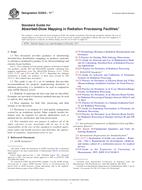Potřebujeme váš souhlas k využití jednotlivých dat, aby se vám mimo jiné mohly ukazovat informace týkající se vašich zájmů. Souhlas udělíte kliknutím na tlačítko „OK“.
ASTM E2303-11e1
Standard Guide for Absorbed-Dose Mapping in Radiation Processing Facilities (Includes all amendments And changes 6/9/2015).
Automaticky přeložený název:
Standardní Guide absorbované dávky mapování v oblasti radiační zařízení na zpracování
NORMA vydána dne 1.7.2011
Informace o normě:
Označení normy: ASTM E2303-11e1
Poznámka: NEPLATNÁ
Datum vydání normy: 1.7.2011
Kód zboží: NS-44988
Počet stran: 11
Přibližná hmotnost: 33 g (0.07 liber)
Země: Americká technická norma
Kategorie: Technické normy ASTM
Anotace textu normy ASTM E2303-11e1 :
Keywords:
absorbed dose, bremsstrahlung, dose distribution, dose mapping, dose zone, dosimetry, electron beam, gamma rays, irradiator characterization, maximum dose, minimum dose, operational qualification, performance qualification, radiation processing, routine process monitoring, sterilization, uncertainty, X-rays, ICS Number Code 13.280 (Radiation protection)
Doplňující informace
| Significance and Use | ||||||
|
This guide is one of a set of guides and practices that provide recommendations for properly implementing dosimetry in radiation processing. In order to understand and effectively use this and other dosimetry standards, consider first “Practice for Dosimetry in Radiation Processing,” ASTM Practice E2628, which describes the basic requirements that apply when making absorbed dose measurements in accordance with the ASTM E10.01 series of dosimetry standards. In addition, ASTM Practice E2628 provides guidance on the selection of dosimetry systems and directs the user to other standards that provide information on individual dosimetry systems, calibration methods, uncertainty estimation and radiation processing applications. Radiation processing is carried out under fixed path conditions where (a) a process load is automatically moved through the radiation field by mechanical means or (b) a process load is irradiated statically by manually placing product at predetermined positions before the process is started. In both cases the process is controlled in such a manner that the process load position(s) and orientation(s) are reproducible within specified limits. Note 2—Static irradiation encompasses irradiation of the process load using either manual rotation, no rotation or automated rotation. Some radiation processing facilities that utilize a fixed conveyor path for routine processing may also characterize a region within the radiation field for static radiation processing, sometimes referred to as “Off Carrier” processing. Many radiation processing applications require a minimum absorbed dose (to achieve a desired effect or to fulfill a legal requirement), and a maximum dose that can be tolerated (while the product, material or substance still meets functional specifications or to fulfill a legal requirement). Dose mapping is used to: Characterize the radiation process and assess the reproducibility of absorbed-dose values, which may be used as part of operational qualification and performance qualification. Determine the spatial distribution of absorbed doses and the zone(s) of maximum and minimum absorbed doses throughout a process load, which may consist of an actual or simulated product. Establish the relationship between the dose at a routine monitoring position and the dose within the minimum and maximum dose zones established for a process load. Verify mathematical dose calculation methods. See ASTM Guide E2232. Determine the effect of process interruptions on the distribution of absorbed dose and the magnitude of the minimum and maximum doses. Assess the impact on the distribution of absorbed dose and the magnitude of the minimum and maximum doses resulting from the transition from one process load to another where changes, for example, in product density or product loading pattern may occur. |
||||||
| 1. Scope | ||||||
|
1.1 This document provides guidance in determining absorbed-dose distributions (mapping) in products, materials or substances irradiated in gamma, X-ray (bremsstrahlung) and electron beam facilities. Note 1—For irradiation of food and the radiation sterilization of health care products, other specific ISO and ISO/ASTM standards containing dose mapping requirements exist. For food irradiation, see ISO/ASTM 51204, Practice for Dosimetry in Gamma Irradiation Facilities for Food Processing and ISO/ASTM 51431, Practice for Dosimetry in Electron Beam and X-Ray (Bremsstrahlung) Irradiation Facilities for Food Processing. For the radiation sterilization of health care products, see ISO 11137-1, Sterilization of Health Care Products Radiation – Part 1: Requirements for Development, Validation and Routine Control of a Sterilization Process for Medical Devices. In those areas covered by ISO 11137-1, that standard takes precedence. ISO/ASTM 51608, Practice for Dosimetry in an X-ray (Bremsstrahlung) Facility for Radiation Processing, ISO/ASTM 51649, Practice for Dosimetry in an Electron Beam Facility for Radiation Processing at Energies between 300 keV and 25 Mev, ISO/ASTM 51702, Practice for Dosimetry in a Gamma Irradiation Facility for Radiation Processing, and ISO/ASTM 51818, Practice for Dosimetry in an Electron Beam Facility for Radiation Processing at Energies Between 80 and 300 KeV also contain dose mapping requirements. 1.2 This guide is one of a set of standards that provides recommendations for properly implementing dosimetry in radiation processing. it is intended to be read in conjunction with ASTM Practice E2628. 1.3 Methods of analyzing the dose map data are described. Examples are provided of statistical methods that may be used to analyze dose map data. 1.4 Dose mapping for bulk flow processing and fluid streams is not discussed. 1.5 Dosimetry is only one component of a total quality program for an irradiation facility. Other controls besides dosimetry may be required for specific applications such as medical device sterilization and food preservation. 1.6 This standard does not purport to address all of the safety concerns, if any, associated with its use. It is the responsibility of the user of this standard to establish appropriate safety and health practices and determine the applicability of regulatory requirements prior to use. |
||||||
| 2. Referenced Documents | ||||||
|
Doporučujeme:
EviZak - všechny zákony včetně jejich evidence na jednom místě
Poskytování aktuálních informací o legislativních předpisech vyhlášených ve Sbírce zákonů od roku 1945.
Aktualizace 2x v měsíci !
Chcete vědět více informací? Podívejte se na tuto stránku.




 Cookies
Cookies
